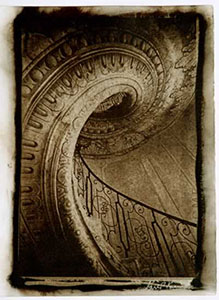 Gumoil & Gravure Processes
Gumoil & Gravure Processes
I work mainly with two processes: polychromatic gumoil, which I discovered in 1990, and non-toxic photogravure which uses Solar Plates. Technical details of each process are described below.
Polychromatic Gumoil Prints
Each gumoil image is hand-crafted after coating a sheet of 100% rag paper with sensitized liquid gum arabic and contact-exposing it to a transparent or translucent positive under intense ultraviolet radiation. The coated sheet is then developed in water, thoroughly dried, and later rubbed with a dark pigment such as lamp black oil paint.
Excess pigment is wiped off and the paper is briefly dipped in a bleach bath to oxidize away (etch) some of the light-hardened residual gum arabic. This leaves the next tonal region of the picture open to a second pigment application.
The sequence is repeated until the print is finished over the course of several days or weeks. It is the successive etchings and applications of oil colors which lead to the richness and dimensionality of the finished print.
Distinguished from hand-coloring, gumoil is a true, though somewhat demanding, photographic print-making technique. Physical size of the gumoils shown here range from 18″x18″ to 18″x24″ printed on 22″x30″ Fabriano paper.
No two gumoil prints made from the same transparent positive can ever be truly identical; there are too many variables for exact replication. Consequently, each print is unique and is offered, signed and dated in limited “variable” editions.
A short video of the gumoil process is available here.
Gravure Prints
Many images in the Gallery are made in modern photogravure. Each is printed in numbered, limited editions and each member of a set is virtually identical.
A transparent positive is contact-printed on a light-sensitive polymer-coated steel plate (such as Solar Plate) and developed in water. The plate becomes an intaglio surface. When cured, the plate is inked up and transferred onto dampened cotton rag paper and hand-pulled through an etching press. Multiple plates may be used in registration and hand-coloring is also possible.
The results are more emotionally evocative than standard silver gelatin photographic prints because the tonal range is more extended and the residual plate tone yields more interesting “white” spaces. Physical sizes of gravure plate images range from about 10″x10″ to 10″x16″.
A short video of the gravure process is available on YouTube.